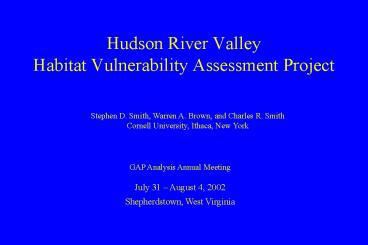Hudson River Valley Habitat Vulnerability Assessment Project - PowerPoint PPT Presentation
1 / 38
Title:
Hudson River Valley Habitat Vulnerability Assessment Project
Description:
Hudson River Estuary Project. NYS Department of Environmental Conservation ... Hudson River Foundation. Vulnerability Index by Town ... – PowerPoint PPT presentation
Number of Views:108
Avg rating:3.0/5.0
Title: Hudson River Valley Habitat Vulnerability Assessment Project
1
Hudson River Valley Habitat Vulnerability
Assessment Project
Stephen D. Smith, Warren A. Brown, and Charles R.
Smith Cornell University, Ithaca, New York
GAP Analysis Annual Meeting July 31 August 4,
2002 Shepherdstown, West Virginia
2
Splash Screen
3
Acknowledgements
- Hudson River Estuary Project
- NYS Department of Environmental Conservation
- Cornell Institute for Resource Information
Systems - Cornell Institute for Social and Economic
Research - New York Cooperative Fish and Wildlife Research
Unit - NYS Gap Analysis Project, Department of Natural
Resources, Cornell University - National Gap Analysis Project, USGS
- Hudson River Foundation
4
(No Transcript)
5
(No Transcript)
6
Vulnerability Index by Town
7
Goals
Habitat Vulnerability Assessment
- develop techniques for analyzing socioeconomic
data to quantify an index of potential human
impacts on biodiversity - utilize developed techniques to assign a habitat
vulnerability index to significant biodiversity
areas
8
Habitat Vulnerability Index
High
Vulnerability Index
Low
Proximity to Potential Growth Areas
Far
Near
Quantifies the vulnerability of biodiversity
areas to potential development impacts
9
The Study Area
Habitat Vulnerability Assessment in the Hudson
River Valley
10
(No Transcript)
11
(No Transcript)
12
Neighborhood Growth Allocation Model Development
Physical Attributes of the Region
Stages of Residential Growth
Social Composition of Neighborhoods
Neighborhood Growth Allocation Model
13
Housing Development 1985 - 1990
- 2,332 Census Block Groups
- 2.3 million population in 1990
- 77,683 housing units built during 85 - 90
Housing Units Built 1985-1990
0 - 25 26 - 74 75 - 161 162 - 306 307 - 820
14
Stages of Residential Growth
Stage 1 Rural -- low population density
Stage 2 First wave of development -- high rates
of new construction
Stage 3 Fully developed -- maximum property
values
Stage 4 Packing -- overcrowding
Stage 5 Thinning -- population decline
Stage 6 Recapture -- property is rehabilitated
15
Defining Neighborhood Growth Stages Step 1
Computing raw stage intensity scores for each
block group using census variables of
population and housing. Step 2 Scaling the raw
stage intensity scores to yield comparable scores
across the study region Step 3 Normalizing
the scaled stage intensity scores to yield the
probability density function and Step 4
Weighting the number of stage by normalized score
to yield the weighted average stage.
16
Neighborhood Growth Stage (1990)
Legend
17
Neighborhood Growth Stage (1990) Albany and
Rensselaer
Legend
18
Housing Unit Growth
19
Initial Housing Market Areas
20
(No Transcript)
21
Neighborhood Growth Allocation Model Development
Physical Attributes of the Region
Stages of Residential Growth
Social Composition of Neighborhoods
Neighborhood Growth Allocation Model
22
Social Composition of NeighborhoodsFactorial
Ecology
Socio-Economic Status
Family Life Cycle
Mobility
Black-White
Urban-Rural
23
Factor 1 SocioEconomic Status
24
Factor 2 Urban - Rural
25
Factor 3 Lifecycle
26
Factor 4 Race
27
Factor 5 Mobility
28
Socioeconomic
Urbanized
Lifecycle
Race
Mobility
29
Neighborhood Growth Allocation Model Development
Physical Attributes of the Region
Stages of Residential Growth
Social Composition of Neighborhoods
Neighborhood Growth Allocation Model
30
Physical Attributes of the Region
Urban Centers and Transportation Network
Major highways with limited access
Major highways without limited access
Local roads
Limited-access interchanges
31
Physical Attributes of the Region
Development Constraints
32
Distance From Urban Area
33
Public Lands
34
NYS DEC Wetlands
35
Model Development Implementation
Stages of Residential Growth Rural, First Wave of
Development, Fully Developed, Packing,
Thinning, Recapture
Physical Attributes of the Region Roads,
Interchanges, Metropolitan Areas, Open Water,
Wetlands, Steep Slopes, Agricultural Districts,
Stewardship Status
Social Ecology of Neighborhoods Socioeconomic,
Urbanized, Lifecycle, Race, Mobility
Neighborhood Growth Allocation Model
Neighborhood Growth Potential
Significant Biodiversity Areas Historic
Sites Public Lands Rare and Endangered Species
Locations
Vulnerability Index
36
Vulnerability Index Based on Housing Stage
37
Contributors
- Stephen D. Smith
- Cornell Institute for Resource Information
Systems - Warren A. Brown
- Cornell Institute for Social and Economic
Research - Yizhao Yang
- Cornell University, College of Architecture, Art,
and Planning, Department of City and Regional
Planning - Charles R. Smith
- Cornell University, College of Agriculture and
Life Sciences, Department of Natural Resources - Milo E. Richmond
- New York Cooperative Fish Wildlife Research
Unit - Stephen D. DeGloria
- Cornell Institute for Resource Information
Systems
38
(No Transcript)































